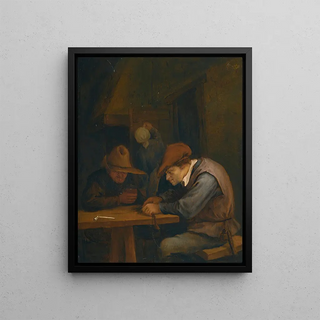Art print | Peasants drinking and cutting tobacco in an inn - Jan Steen


View from behind

Frame (optional)
In the vibrant world of 17th-century Dutch painting, the art print "Paysans buvant et coupant du tabac dans une auberge" by Jan Steen stands out for its liveliness and authenticity. Through this scene of everyday life, the artist immerses us in the intimacy of a shared moment among peasants, where tobacco, newly introduced to Europe, becomes the pretext for palpable conviviality. The characters, depicted with striking expressiveness, seem animated by simple joy, capturing the very essence of rural life. This detailed art print invites the viewer to delve into a universe where time appears suspended, where every gesture, every glance tells a story.
Style and uniqueness of the artwork
Jan Steen's style is characterized by vibrant realism and meticulous attention to detail, which give his art prints a rare emotional depth. In "Paysans buvant et coupant du tabac dans une auberge," warm colors and play of light create a welcoming atmosphere, while the dynamic composition, with figures arranged to guide the eye, reveals a keen sense of storytelling. The facial expressions of the characters, oscillating between joy and melancholy, demonstrate an exceptional mastery of portrait art. Every element, from the beer glass to the tobacco pipe, contributes to the harmony of the scene, making this art print a precious testament to the popular culture of the time.
The artist and his influence
Jan Steen, one of the masters of genre painting, captured the spirit of his era with remarkable acuity. Born in Leiden in 1626, he began his career as a painter of religious scenes before turning to depictions of daily life. His work is often imbued with subtle humor and social critique, revealing the flaws of his contemporaries while celebrating their humanity. Steen influenced many artists, both through his style and his ability to tell stories through painting. His art prints, such as "Paysans buvant et coupant du tabac dans une auberge," remain essential references for understanding the social dynamics and

Matte finish

View from behind

Frame (optional)
In the vibrant world of 17th-century Dutch painting, the art print "Paysans buvant et coupant du tabac dans une auberge" by Jan Steen stands out for its liveliness and authenticity. Through this scene of everyday life, the artist immerses us in the intimacy of a shared moment among peasants, where tobacco, newly introduced to Europe, becomes the pretext for palpable conviviality. The characters, depicted with striking expressiveness, seem animated by simple joy, capturing the very essence of rural life. This detailed art print invites the viewer to delve into a universe where time appears suspended, where every gesture, every glance tells a story.
Style and uniqueness of the artwork
Jan Steen's style is characterized by vibrant realism and meticulous attention to detail, which give his art prints a rare emotional depth. In "Paysans buvant et coupant du tabac dans une auberge," warm colors and play of light create a welcoming atmosphere, while the dynamic composition, with figures arranged to guide the eye, reveals a keen sense of storytelling. The facial expressions of the characters, oscillating between joy and melancholy, demonstrate an exceptional mastery of portrait art. Every element, from the beer glass to the tobacco pipe, contributes to the harmony of the scene, making this art print a precious testament to the popular culture of the time.
The artist and his influence
Jan Steen, one of the masters of genre painting, captured the spirit of his era with remarkable acuity. Born in Leiden in 1626, he began his career as a painter of religious scenes before turning to depictions of daily life. His work is often imbued with subtle humor and social critique, revealing the flaws of his contemporaries while celebrating their humanity. Steen influenced many artists, both through his style and his ability to tell stories through painting. His art prints, such as "Paysans buvant et coupant du tabac dans une auberge," remain essential references for understanding the social dynamics and






